 Back to selection
Back to selection
Shutter Angles
Conversations with DPs, directors and below-the-line crew by Matt Mulcahey
“If You Put Up a Video Village You’re Going to Get 10% Less Material Every Day”: DP Giles Nuttgens on Hell or High Water
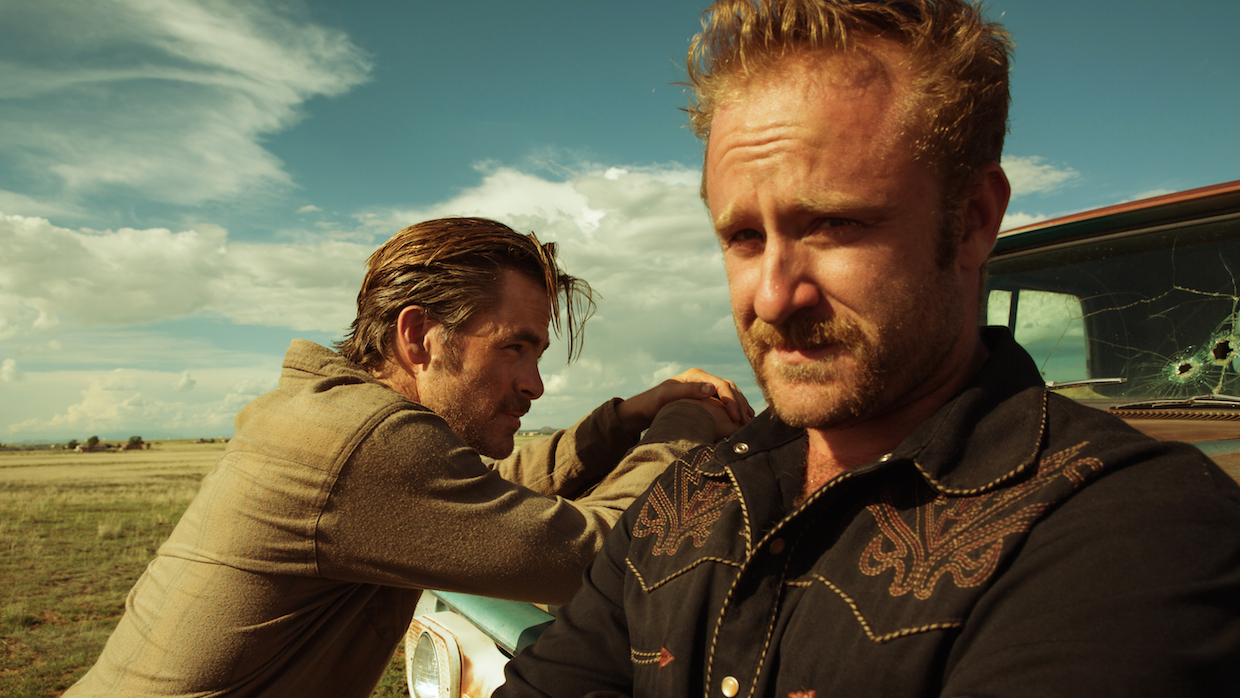 Chris Pine and Ben Foster in Hell or High Water
Chris Pine and Ben Foster in Hell or High Water In Hell or High Water two brothers (Chris Pine and Ben Foster) embark on a spree of heists intended to fleece predatory Texas banks, with an about-to-retire Texas Ranger (Jeff Bridges) hot on their heels.
The film is an elegy to a dying way of life – not only for family ranchers Pine and Foster, but also for lawman Bridges. Making the movie was an elegy of sorts as well for cinematographer Giles Nuttgens, a vocal celluloid proponent who ultimately opted to shoot with an Alexa Studio on the project. In the words of another great western requiem The Wild Bunch, “It ain’t like it used to be, but it’ll do.” And regardless of the format, Nuttgens’ work in Hell or High Water will certainly do.
Filmmaker: The last time I interviewed you was for Young Ones and God Help the Girl. If you watched those movies along with Hell or High Water I don’t think you would guess that they were all shot by the same cinematographer. Do you think you have a recognizable style?
Nuttgens: I always felt like a chameleon. So I’m quite pleased that some people have started to pick up on that. Very early on I talked to a few different agents about it, and they felt that constantly changing my approach to lighting wouldn’t necessarily be the most helpful thing for my career. Refining a specific style or at least working within a similar space means that your advancement within that particular style is much faster. But I always thought if I could adapt to any style I would not just be a more flexible DP but I would be a better one. The other thing is that I’ve never seen two scripts that are the same. So allowing that all stories are different, it seems to me that one part of my job should be to apply something unique to each specific picture.
Filmmaker: Both Young Ones and God Help the Girl were shot on film – the former on 35mm and the latter on 16mm. What made you go digital for Hell or High Water?
Nuttgens: We actually contemplated shooting some of the wider landscapes in Hell or High Water on 65mm film. That was a little before I had really seen the amazing results from the Alexa 65. We thought that this film would benefit from that scale of vision. So we did contemplate it and we contemplated it right up until somebody on the production side said “no.” (laughs)
With any shoot you have to look at the schedule and you have to look at what you want to do within that schedule. One of the things that [Hell or High Water director] David Mackenzie and I wanted to do is shoot single camera on all but the action scenes, so we had to be realistic about the working practices that would allow us to make our days and give David some freedom in the edit while allowing the actors the time to do these amazing performances. One of the big things that came out of this film is the level of improvisation, not just from Jeff and Gil [Birmingham, who plays Bridges’ partner], but even between Chris and Ben. David encouraged that by doing one or two extra takes and saying to the guys, “Do what you want” or “Try to do it without words.” So anything on the technical side that would’ve eaten up that extra time, in the long run it would’ve been detrimental to the film.
Filmmaker: And you did 10-hour days instead of typical 12-hour days, which gave you an even more condensed schedule. It must have been nice to work a somewhat more reasonable day though.
Nuttgens: One of the great things about the 10-hour day is that you hold your maximum level of energy throughout those hours. Potentially you might end up with one less set-up per day — although we often think we get more — but chances are you’ve been more refined about the type of work you’ve done just simply because the energy is higher and I think that’s a very infectious thing.
At first the crew looked at us like, “This is not going to work,” because they believed that we would carry on after 10 hours [regardless of what we told them]. But when they realized that at 10 hours they were going home, then suddenly they paced themselves in a very different way and that was absolutely fantastic for Chris and Ben. If they get more takes because we’re working faster, then they’re going to experiment more and I think that really shows in the film.
Filmmaker: David does some unique things to maintain that pace. He doesn’t slate takes and rather than having a video village he just has one small director’s monitor for him next to the camera.
Nuttgens: As far as I’m concerned, if you put up a video village you’re going to get 10% less material every day. Work that out and it’s a potential loss of a million dollars on a picture like this, which should make us all think. The trick to making creative space within the shooting day is getting [the camera] to turn over as soon as possible. That means keeping things simple.
I worked with Lucasfilm on Attack of the Clones with a Sony [F900] and it was a terribly limited camera, but it was a breakthrough in terms of high definition being acceptable within the system. George Lucas’ intention was actually to reduce the technology between the director and the performances. He always thought that film was an element that slowed him up. Simple things like changing magazines got in the way and if you had to reload between takes the energy would go and the actors would have to build back up again.
George wanted to reduce the amount of technical filtration in between turning up on set and actually getting something in the can, but I don’t think that’s what happened. We converted a loader into a DIT who has a tent and added an ever-expanding video village. There seems to be a lot of baggage that comes along with the digital system. It’s been frustrating because I had a process on film that worked for me and was fast and flexible. I knew exactly what I was going to get when I was looking through a viewfinder. Now the technology seems to have taken over and that wasn’t the intention.
Filmmaker: How does that wish to simplify the process of seeing an image on set translate to the way you monitor on a movie like Hell or High Water? Are you using LUTs or live grading on set or are you just placing a Rec709 correction on the Alexa Raw footage?
Nuttgens: I have no idea how anyone grades on set or why they would wish to do so. I light the way I want it to look on the final grade. I also operate so my time is 100% on camera or with the director, actors, or gaffer. Ideally I would feed LUTs into the small DP7-Pro that I have onboard the camera. But despite the fact that I always say on my first meeting with the producer, “I’m going to need specific testing and prep time to set up my LUTs,” it’s never happened for me yet. What happens more often than not is that I end up using a Rec709 LUT on set. It’s not ideal but at least it’s like working to a one-light print.
However, irrespective of an applied LUT, a monitor has a much higher luminance level than a big screen so its contrast is very different. Using a monitor to judge what will be shown on a big screen is still an interpretive process, particularly in the shadow areas and the nature of the blacks.
The ideal thing for me would be to get back to a place where I can look through a viewfinder — I use an Alexa Studio camera so I have an optical viewfinder — and see with complete confidence what the final image will look like. Then we’d be back to interpreting using our eyes, our brains, and a light meter. That is not only a very fast, very efficient system, it is also a holistic system where I am not just dealing with a single image but my mind holds all that has already been shot and my intentions for everything that will be shot. Every moment it is all being processed through the same storage facility — my brain — and that process of analysis happens a million times faster than my legs can walk to a DIT’s tent.
Filmmaker: Tell me about this scouting trip you took to Texas. You ultimately shot in New Mexico, but you spent a week going through these little towns in Texas with David and a few other crewmembers.
Nuttgens: We wanted to know what the type of town that Taylor Sheridan had written about looked like. As outsiders we didn’t have those references, so we wanted to try to imbibe the feeling of a certain part of Texas that had been left behind by modern economic development. The first place that we went was Archer City and we turned up on the main street — this windswept place where you can easily imagine what it was like decades earlier. We literally just set off separately in different directions to try to experience what it was like to sit at the crossroads in the middle of nowhere in this very small town. I found the facade of the cinema from The Last Picture Show. I didn’t recognize it at first but then I saw someone with a stills camera who was obviously on a pilgrimage to see the theater. With the searing hot wind blowing dust along the streets you could feel why a place like that would die, and from only the first half-hour on that scout we all had an idea of the harshness that would form the backbone of our characters.
From Archer City we went to a place called Hope, another single street town with most of the places closed, a sun-bleached sign on the barber’s shop saying going out of business after 40 years of trade, and a bar that, believe it or not, didn’t have any alcohol. I talked to a guy of Hispanic origin who had a ranch there and he was moving. He’d spent his whole life in Hope, but he’d just given up and sold the land off. He’d grown up there. His grandparents had grown up there. They’d been workers and then they’d bought the ranch — an old time American success story. But in the end he’d had to leave too. That’s what that week of scouting served for — feeling what was happening to the people who were living within that landscape.
Filmmaker: Let’s jump ahead to the first day of principal photography. The very first thing you roll on is the long, complicated tracking shot that opens the movie. That goes against conventional wisdom, which is usually to kind of ease into that first day while everyone gets acclimated to each other.
Nuttgens: I would’ve agreed with you before doing it and I maybe still agree after. (laughs) In the past David and I have done a lot of work handheld, because we can move faster that way and get a lot of coverage. But for Hell or High Water David said that he wanted to do something different and he preferred to do a lot of things in single shots. And I thought, “If that’s the intention, then let’s start off with that intention.”
David had already come up with the idea of showing the lack of presence of people during the opening robbery – that the brothers were hitting the bank earlier when there was no risk. That’s extremely important narratively because Toby (Pine) wouldn’t have taken this on if there’d been a risk. You have to believe that Toby, if he had his way, wouldn’t have had bullets in his gun. He just needed this money and the last thing he wanted to do was to hurt anybody in the process. David felt that we could show that by showing the space with a long developing shot that saw 360 degrees. We wanted to see that the whole town was dead.
The sad thing about that shot was that I’d been to that location at dawn for the three previous days watching the sun come up and how it hit the buildings and figuring out exactly what time we needed to shoot. And of course on the day that we turn up with the whole crew, it’s overcast. It’s a white detail-less sky and there’s no shadows whatsoever. We had hoped that would be a much more dramatic shot and we had to do a little bit of manipulation in post to give it more force.
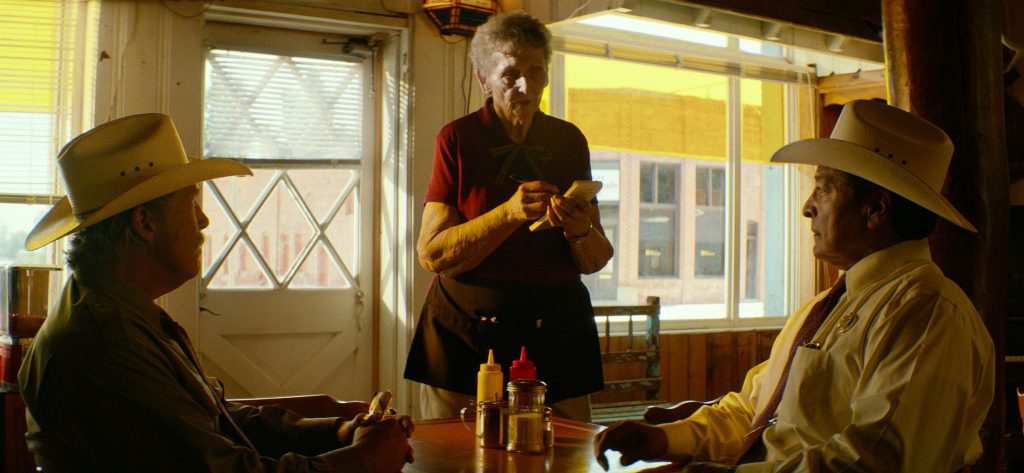
Filmmaker: Let’s get into some specific scenes, starting with Marcus [Bridges] and Alberto [Birmingham[ staking out a branch of the Texas Midland Bank from the confines of a local diner.
Nuttgens: This whole scene is a slice of the past because this diner doesn’t accommodate modern desires, where you have a lot of options. It is demonstrative of the sleepy lost town of Coleman. When I first put the camera up Patrick Quinn, the 1st AC, had the stop at T2.8 so that he could see Jeff clearly and he was surprised when I stopped down to T8/11, which put Jeff in silhouette because what’s actually important here is seeing what’s outside — the Texas Midland Bank.
The shot at the head of this scene originally had a big preamble, which isn’t in the final film, where we see the waitress serving other people and then we do a huge pan around of something like 210 degrees to see Jeff and Gil arriving and then we tracked into the master 3-Shot. I was limited by the first developing shot as to how I could approach the lighting. The whole scene is actually lit by one 18K. There’s obviously risk in using hard lighting on an 80-year-old woman with an intense HMI hitting her face — and I still debate whether I should’ve softened it on her — but this scene feels as hot and as brutal as we wanted it to in that small town. All of the angles were shot without changing the lighting, with the exception of a bounce card for a bit of fill on Jeff’s mid-close up.
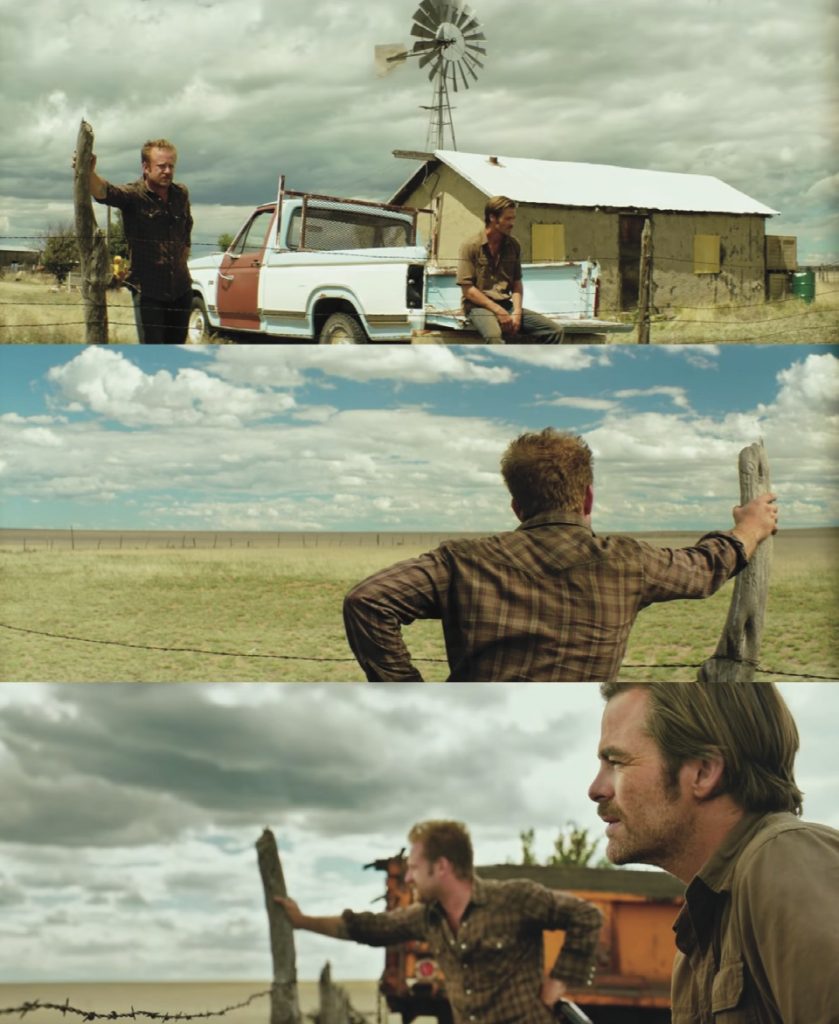
Filmmaker: The next shot is of the two brothers sharing a wordless moment as they peer out at the barren landscape of the family ranch.
Nuttgens: It’s one of the few times we see Tanner (Foster) actually get emotional. There’s no doubt about what he’s doing here – he’s looking out at a lost life.
They are victims of the oppressive nature of their environment. It can be beautiful but it’s not beautiful when it’s in drought and the land can’t produce anything.
The reason why we shot on Scope is to get frames like these. And the frames are very specific. For example with the frame of Ben [where the camera is behind him], we didn’t want him to be crunched by the edge of the frame. We wanted him to instead be diminished by the power of the landscape in front of him and to feel the impotence of being in that space.
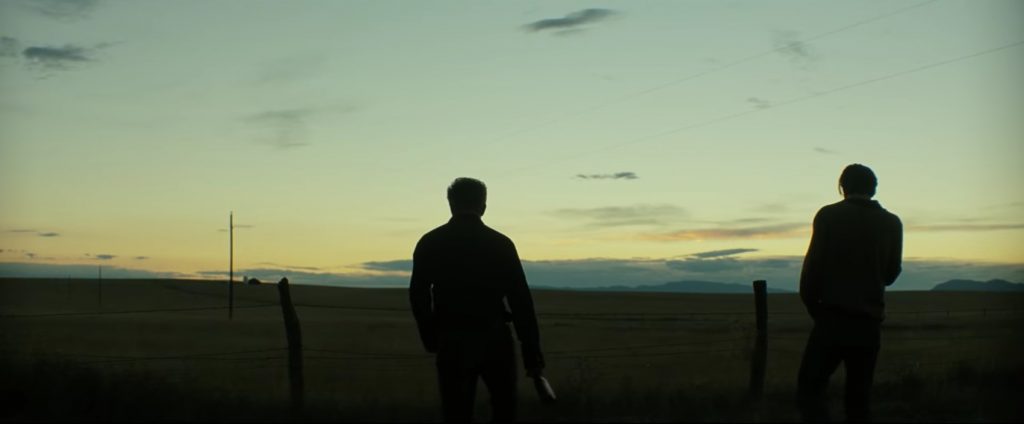
Filmmaker: The next frame is another moment between the two brothers, where they playfully wrestle at dusk. Chris Pine has said this moment was improvised because a lightning strike forced you to shut down all the lights.
Nuttgens: New Mexico is the most amazing place on the planet. It’s just fantastic. But the problem with shooting in New Mexico in the summer is that towards every afternoon a lightning storm starts. So you have amazing skies, but if you’re within a mile of a lightning strike you have to shut down for half-an-hour. Then every time there’s another lightning strike, that time resets. So on the day we shot this scene, our day had been destroyed by those delays. We lost half-a-day to the lightning storm. Everybody sort of sat down and had coffee and figured we’d be down for an hour or two. But David and I said, “We’re going to shoot something.” We just set Chris and Ben off and the idea was that they would contemplate the landscape that they had grown up next to but then they started messing around and that became the scene. It was actually a very long shot — maybe two or three minutes. It’s the end of the day and it’s the end of a period in their lives because the next day it all pretty much goes to shit in the narrative.
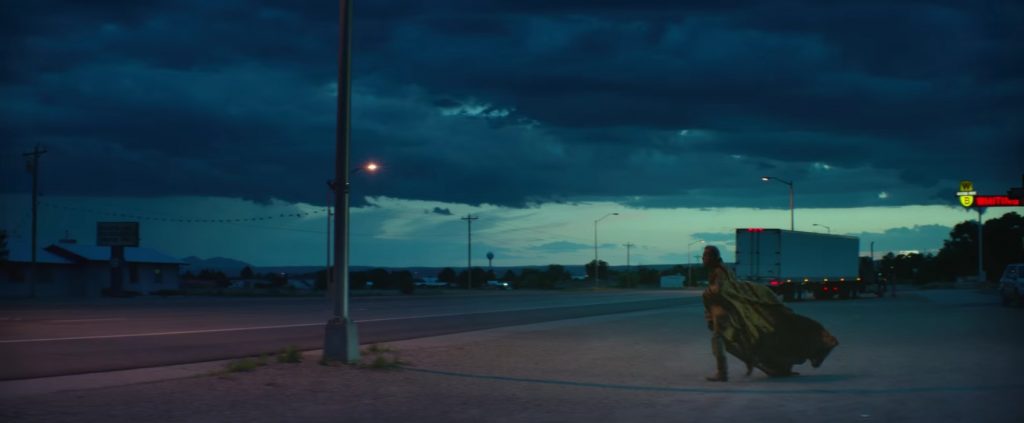
Filmmaker: Let’s finish up with one of my favorite images in the film — Jeff Bridges, cloaked in a motel bedspread, marching across an interstate under a beautiful sunset.
Nuttgens: Originally in the script he walked across that street and went into a field and he screamed at God, but (the last part of that scene) never made it past the edit. Jeff really emoted and it was fairly theatrical and we had a very theatrical sky to go with it. I wish there was a bit more of that scene in the final film. That scene had to do with Jeff’s retirement and the loss of his wife and the fact that everything for him was coming to an end. That’s the great thing about Taylor Sheridan’s writing. It’s not just the cop who is retiring. We’ve seen that a million times. It’s actually about two groups of people who are reaching, one way or another, a huge crossroads within their lives. What lies ahead, they don’t know. David has always taken on projects with an interesting moral viewpoint and this film is very morally ambivalent. It’s one of the things that people have responded to. Jeff Bridges’ character is pretty much the same kind of guy as Chris Pine’s character. You understand that these people come from the same place. They just happen to have taken different turns in their lives.
Matt Mulcahey writes about film on his blog Deep Fried Movies.
